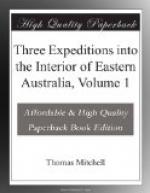December 10.
The morning was cloudy; and the rain, which we anxiously looked for, at length came down, and soon checked the progress of the flames. On this account, as well as on that of the want of water, it afforded providential relief to us, for the hills we were about to cross had been all in a blaze during the night. Trees lay smoking as we passed; several gullies were difficult for the passage of carts, and detained the party in its ascent.
CROSS THE TURI RANGE.
But at length we reached the top of this pass, and crossed the range, which appeared to be continuous, thus separating the basin of the Peel from that of the waters falling to Liverpool plains. We were agreeably surprised to find that the opposite side of these hills, and the whole face of the country beyond them, presented a very different appearance from that through which we had passed. A gently sloping extremity lay before us for eight miles in the direction of our proposed route, and we were relieved from all the difficulties of crossing gullies, which had impeded our ascent on the other side of the range. We encamped at some waterholes, where this slope terminated in an extensive forest flat; over the whole of which, as my sable guide informed me, there was no other water at that time.
The grass on this side of the hills was good: and almost all the timber consisted of box (eucalyptus). The heights which we had crossed appeared to extend from the Liverpool range to the northward, as far as could be seen; but the native told me, that it soon terminated on the river Callala (or Peel) whose course, he said, turned westward (as he pointed); a fact corroborating so far, the statements of The Bushranger.
ARRIVE ON THE RIVER PEEL.
December 11.
The weather cleared up at about six A.M.: and we travelled across a good soil, throughout the whole of this day’s journey. The country appeared but thinly wooded, and without any hill or watercourse. After a journey of thirteen miles, we reached the bank of the Peel at Wallamoul, the lowest cattle station upon this river. It was occupied by Mr. Brown, who had there about 1600 head of cattle. I gave to Jemmy, our excellent guide, the promised tomahawk, also a knife to Monday his brother, whom he met here. The river was so low that Mr. White and I passed over easily on a tree which the flood had laid across it. The current however was strong; and the men having been furnished from our stock with a few hooks and lines, caught three large fishes by sunset. I met, at this place, with some intelligent natives, from whom I learnt, that the spot where Mr. Oxley crossed the Peel on his journey, was about two miles lower down.
FISHES.
December 12.
At an early hour this morning, one of our men caught a fish, which weighed eighteen pounds; but, according to the natives, this was no uncommon size. These fishes are most erroneously called cod by the colonists, although they certainly very much resemble cod in taste. The flakes are firmer than sea cod, and equally white, the fish affording a very light and palatable food. When dried in the same manner as the Newfoundland cod, in which state I have tasted this fish at Bathurst, I could not perceive any difference either in flavour or appearance.




